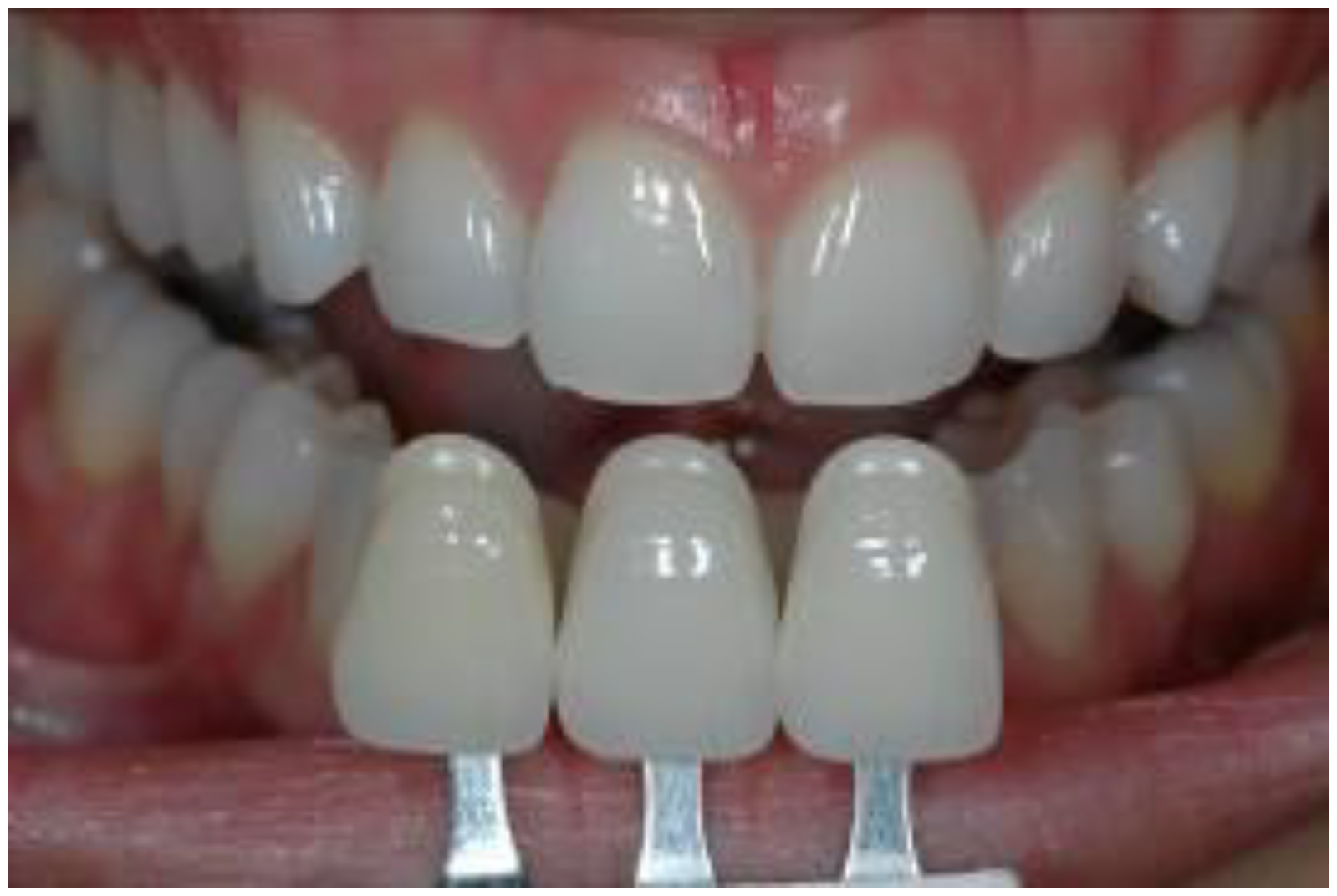Digital Computer Matching of Tooth Color
Abstract
:1. Introduction
2. Results and Discussion
2.1. Experiment I—Matching of Duplicate Shade Guide Teeth and Photography
2.2. Experiment II (Clinical)—Visual Shade Matching of Human Teeth
3. Experimental Section
3.1. Experiment I—Matching of Duplicate Shade Guide Teeth and Photography

3.2. Experiment II (Clinical)—Visual Shade Matching of Human Teeth

3.3. Statistical Analysis
4. Conclusions
Acknowledgement
References and Notes
- Dancy, W.K.; Yaman, P.; Dennison, J.B.; O’Brien, W.J.; Razzoog, M.E. Color measurements as quality criteria for clinical shade matching of porcelain crowns. J. Esthet. Restor. Dent. 2003, 15, 114–121. [Google Scholar] [CrossRef] [PubMed]
- Hammad, I.A. Intrarater repeatability of shade selections with two shade guides. J. Prosthet. Dent. 2003, 89, 50–53. [Google Scholar] [CrossRef] [PubMed]
- Lagouvardos, P.E.; Diamanti, H.; Polyzois, G. Effect of individual shades on reliability and validity of observers in colour matching. Eur. J. Prosthodont. Restor. Dent. 2004, 12, 51–56. [Google Scholar] [PubMed]
- Oh, W.; Koh, I.W.; O’Brien, W. Estimation of visual shade matching errors with two shade guides. Quintessence Int. 2009, 40, 833–836. [Google Scholar] [PubMed]
- Culpepper, W. A comparative study of shade-matching procedures. J. Prosthet. Dent. 1970, 24, 166–173. [Google Scholar] [CrossRef] [PubMed]
- Davis, L.G.; Ashworth, P.D.; Spriggs, L.S. Psychological effects of aesthetic dental treatment. J. Dent. 1998, 26, 547–554. [Google Scholar] [CrossRef] [PubMed]
- O’Brien, W.J.; Boenke, K.M.; Groh, C.L. Coverage errors of two shade guides. Int. J. Prosthodont. 1991, 4, 45–50. [Google Scholar] [PubMed]
- Jarad, F.D.; Russell, M.D.; Moss, B.W. The use of digital imaging for colour matching and communication in restorative dentistry. Br. Dent. J. 2005, 199, 43–49. [Google Scholar] [CrossRef] [PubMed]
- Hugo, B.; Witzel, T.; Klaiber, B. Comparison of in vivo visual and computer-aided tooth shade determination. Clin. Oral Investig. 2005, 9, 244–250. [Google Scholar] [CrossRef] [PubMed]
- Hassel, A.J.; Grossmann, A.C.; Schmitter, M.; Balke, Z.; Buzello, A.M. Interexaminer reliability in clinical measurement of L*C*h* values of anterior teeth using a spectrophotometer. Int. J. Prosthodont. 2007, 20, 79–84. [Google Scholar] [PubMed]
- Bolt, R.A.; Bosch, J.J.; Coops, J.C. Influence of window size in small-window colour measurement, particularly of teeth. Phys. Med. Biol. 1994, 39, 1133–1142. [Google Scholar] [CrossRef] [PubMed]
- Bentley, C.; Leonard, R.H.; Nelson, C.F.; Bentley, S.A. Quantitation of vital bleaching by computer analysis of photographic images. J. Am. Dent. Assoc. 1999, 130, 809–816. [Google Scholar] [CrossRef] [PubMed]
- Bengel, W.M. Digital photography and the assessment of therapeutic results after bleaching procedures. J. Esthet. Restor. Dent. 2003, 15, S21–S32. [Google Scholar] [CrossRef] [PubMed]
- Knösel, M.; Attin, R.; Jung, K.; Brunner, E.; Kubein-Meesenburg, D.; Attin, T. Digital image color analysis compared to direct dental CIE colorimeter assessment under different ambient conditions. Am. J. Dent. 2009, 22, 67–72. [Google Scholar] [PubMed]
- O’Brien, W.J. Color and Appearance. In Dental Materials and Their Selection, 4th ed.; Quintessence: Chicago, IL, USA, 2008; pp. 28–30. [Google Scholar]
© 2010 by the authors; licensee MDPI, Basel, Switzerland. This article is an open access article distributed under the terms and conditions of the Creative Commons Attribution license (http://creativecommons.org/licenses/by/3.0/).
Share and Cite
Oh, W.-s.; Pogoncheff, J.; O’Brien, W.J. Digital Computer Matching of Tooth Color. Materials 2010, 3, 3694-3699. https://doi.org/10.3390/ma3063694
Oh W-s, Pogoncheff J, O’Brien WJ. Digital Computer Matching of Tooth Color. Materials. 2010; 3(6):3694-3699. https://doi.org/10.3390/ma3063694
Chicago/Turabian StyleOh, Won-suk, John Pogoncheff, and William J. O’Brien. 2010. "Digital Computer Matching of Tooth Color" Materials 3, no. 6: 3694-3699. https://doi.org/10.3390/ma3063694



